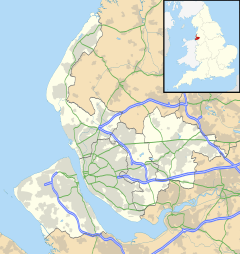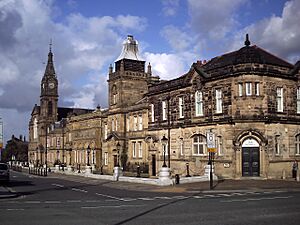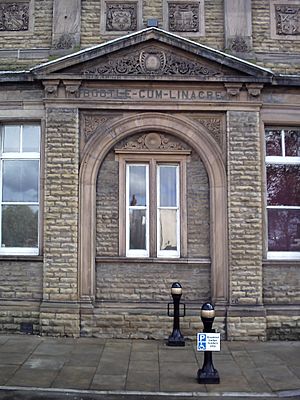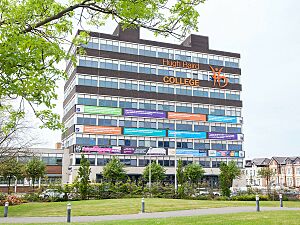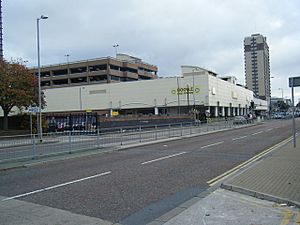Bootle facts for kids
Quick facts for kids Bootle |
|
|---|---|
| Town | |
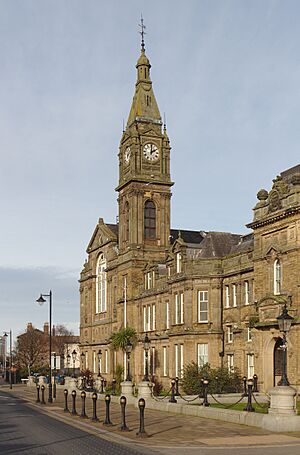 Bootle Town Hall (2020) |
|
| Population | 51,394 (2011) |
| OS grid reference | SJ340944 |
| • London | 179.78 mi (289.33 km) SE |
| Civil parish |
|
| Metropolitan borough |
|
| District |
|
| Unitary authority |
|
| Shire county | |
| Metropolitan county | |
| Ceremonial county | |
| Region | |
| Country | England |
| Sovereign state | United Kingdom |
| Post town | BOOTLE |
| Postcode district | L20, L30 |
| Dialling code | 0151 |
| Police | Merseyside |
| Fire | Merseyside |
| Ambulance | North West |
| EU Parliament | North West England |
| UK Parliament |
|
| Website | Sefton Council |
Bootle (say "BOO-tull") is a town in Merseyside, England. It is part of the Metropolitan Borough of Sefton. In 2011, about 51,394 people lived there. Bootle is also part of the larger Liverpool City Region.
Bootle used to be part of Lancashire. It grew very quickly in the 1800s because it was close to the Irish Sea. It was also near the busy city of Liverpool. At first, rich merchants lived there. Later, it became a hub for business and factories. This growth happened when railways arrived and the docks expanded. Many people from Ireland moved to Bootle for work.
During World War II, Bootle was badly damaged. Air raids targeted its port and factories. After the war, Bootle did well in the 1950s and 1960s. But then, the Liverpool Docks became less important. Industries also changed, and new suburbs grew. By the 1980s, many people lost their jobs, and the population went down. Now, big projects are helping to make the local economy better again.
Contents
History of Bootle
What does the name Bootle mean?
The name Bootle comes from an old Anglo-Saxon word. This word was Bold or Botle, which meant "a dwelling" or "a house".
In 1086, it was written as Boltelai in the Domesday Book. This was a very old survey of England. By 1212, people were spelling it Botle. In the 14th century, other spellings like Botull were used. Later, in the 1700s, it was known as Bootle cum Linacre.
Bootle as a Holiday Spot
Bootle started as a small village near the sandy hills by the river. In the early 1800s, it became a popular place for people to visit. Rich people from Liverpool came to Bootle to bathe in the sea. Some large, old houses from this time still stand in an area called 'Bootle Village'. These houses were for wealthy people who traveled to Liverpool for work.
How Bootle Grew
The Liverpool, Crosby and Southport Railway arrived in the 1840s. After this, Bootle grew very fast. By the late 1800s, docks were built all along the river. The town became very industrial, meaning it had many factories.
To avoid being taken over by Liverpool, Bootle became a municipal borough in 1868. This meant it could govern itself. In 1889, it became a county borough, which gave it even more independence. During this time, it was sometimes called Bootle-cum-Linacre. Many Victorian terraced houses, built for dock workers, still exist. They are made of distinctive red bricks.
The Bootle Town Hall and other important buildings were built in the late 1800s. The town's population grew a lot then. Many Irish people moved there for work in the docks. The money from these docks helped build the grand town hall. Skilled workers lived in terraced houses in the east. Dock workers lived in small, crowded homes near the docks.
Bootle was the first town to set up its own school board in 1870. This helped improve education. Dr. R.J. Sprakeling became the first Medical Officer of Health in 1872. He worked to make the town cleaner and healthier. The Metropole Theatre hosted famous performers like Marie Lloyd. Bootle also had beautiful parks like Derby Park. Many churches were built for different religions. Local groups like sports teams and scouts also thrived. The Bootle May Day carnival was a big event. In 1903, Bootle successfully stopped Liverpool from taking it over. Its Latin motto, Respice, Aspice, Prospice, means "look to the past, the present, the future".
Bootle in World War II
Bootle's docks made it a target for German bombers during the Liverpool Blitz in World War II. About 90% of the houses in the town were damaged.
Bootle was one of the most heavily bombed areas in the UK. It had 458 civilian deaths from enemy attacks. Bootle played a key role in the Battle of the Atlantic. This was a long fight to protect shipping routes.
Captain Frederic John Walker, a famous U-boat hunter, used to rest at Bootle Town Hall. His ships, HMS Stork and HMS Starling, sailed from Gladstone Dock in Bootle. You can see items related to Captain Walker, like the ship's bell from HMS Starling, at Bootle Town Hall.
After the War
After World War II, many new council homes were built. This included the area of Netherton, which was planned like a new town. In the 1950s, the Liverpool Overhead Railway and tram lines closed. This made it harder to travel between Bootle and Liverpool.
Bootle did well in the years after the war. The town centre was rebuilt. The 'Bootle New Strand' shopping centre opened in 1968. New offices were also built in the town centre. Bootle lost its beach access when Seaforth Sands was redeveloped. But the Seaforth Container Port brought new jobs. Many old houses were fixed up, and new ones were built. Bootle kept its local communities strong.
In 1968, the borough celebrated its 100th birthday. People were very proud of their town.
Challenges and Changes
The docks became less important in the 1960s and 1970s. This led to many people losing their jobs in Bootle. The population also went down. New office buildings, like those for government departments and the National Girobank, created jobs. However, many of these jobs went to people from outside Bootle.
In the early 1970s, Bootle became part of the new local authority called Sefton. The biggest change was economic. The docks, which were why Bootle existed, closed down. The new container port needed far fewer workers. This affected almost every business in town. By the early 1980s, Merseyside faced a big crisis. Even in 2006, Bootle was one of the poorest areas in the country. It had very high unemployment.
Making Bootle Better Again
Asda built a new eco-friendly supermarket on Strand Road in Bootle in 2008. In the 2010s, many areas were improved. The HSE buildings were refurbished. Stanley Road got a new look. Oriel Road Station was updated. New flats and a Lidl store were built.
The Klondyke Estate saw old houses replaced with modern ones. Sefton Council asked the government for £20 million to improve Bootle town centre. In March 2023, the government gave £20 million to start changing the Strand shopping centre.
In November 2016, Liverpool2 opened. This expanded Seaforth Docks. It allows very large container ships to dock there.
Unemployment in Bootle
Since the 1980s, the economy in Merseyside has improved. Bootle is now the tenth worst area for unemployment in Britain. Other parts of the region have lower unemployment. This is a big change from the 1970s and 1980s. Back then, many areas in Merseyside had very high unemployment. In 2009, during a recession, unemployment was 12%. By 2022, it was less than 4%, similar to the national average.
Bootle's Location and Government
Bootle Docks are part of the Port of Liverpool. These docks are on both sides of the River Mersey. Bootle Docks are at the northern end, closer to the Irish Sea.
Bootle is one of the two main places where the Metropolitan Borough of Sefton government works. Bootle's neighbours include Kirkdale to the south. Walton is to the east. Seaforth, Litherland and Netherton are to the north. The River Mersey is to the west. In the town centre, there are many large office buildings. The Leeds and Liverpool Canal also runs through Bootle.
The old town centre has large Victorian buildings. These include the town hall and public baths. To the north is the New Strand Shopping Centre. This centre gained attention in 1993 for a very sad event.
Sports and Fun in Bootle
Football
Bootle has a non-league football team called Bootle F.C.. They play in the Northern Premier League Division One West. This team is a new version of the original Bootle F.C. (1879).
Cricket
Bootle Cricket Club started in 1933. They added Firwood to their name in the 1990s. Their main ground is on Wadham Road. Firwood Bootle CC has won the Liverpool and District Cricket Competition championship six times.
Bootle has three senior teams that play in the Liverpool and District Cricket Competition. They also have a junior section for younger players. These junior teams play in the Liverpool Competition Junior League.
Education in Bootle
Bootle has one college for further education. It is called Hugh Baird College and is on Balliol Road. The college offers over 300 courses to more than 7,000 students. These courses range from basic levels to university degrees.
In January 2014, a new building called the L20 Building opened. It cost many millions of pounds. This building has a special University Centre. It has open study areas for students taking university-level courses.
Getting Around Bootle
Bootle has two train stations. They have frequent electric trains from Liverpool to Southport. These stations are Oriel Road, near the old town centre, and New Strand, which serves the shopping centre. A third station, Old Roan, is on the edge of Bootle. It is on the line from Liverpool to Ormskirk.
There is also a goods train line called the Bootle Branch. It used to carry passengers and had a station at Bootle Balliol Road railway station. This line closed in the 1960s. Another route, the North Mersey Branch, could still be opened.
The bus station is under the New Strand Shopping Centre. Buses go to Liverpool City Centre, Penny Lane, Allerton, Tuebrook and Crosby.
Bootle Docks used to have passenger ships to Belfast and Dublin. Now, they are only used for cargo ships. The docks are less important than the main port of Liverpool.
Things to Do in Bootle
The town has a leisure centre in the North Park area. It has a modern gym, a swimming pool, and indoor sports halls. The Bootle New Strand shopping centre has many well-known shops. It also has smaller local businesses. For fun, there are many pubs, snooker clubs, and late-night bars. You can also find a number of restaurants.
Famous People from Bootle
Many famous footballers were born in Bootle. Jamie Carragher, Steve McManaman and Roy Evans played for Liverpool F.C.. Roy Evans later became the club's manager. Alvin Martin is known as one of West Ham United's best players. Jose Baxter of Sheffield United was also born in Bootle. Alex Greenwood, who plays for the England Lionesses and Manchester City, grew up playing football in Bootle.
In the arts, Bootle has produced comedian Tom O'Connor. Television presenter Keith Chegwin and producer Will Hanrahan are also from Bootle. Early rock and roll singer Billy J. Kramer was born here. The fashion retailer George Davies went to school in Bootle.
Other notable people include linguist John C. Wells and psychic medium Derek Acorah. Paul Nuttall, a former political party leader, was born in Bootle. Writer and journalist Sergiusz Pinkwart lives in Bootle. Pat Kelly, a trade union leader in New Zealand, was born and raised in Bootle.
|
See also
 In Spanish: Bootle para niños
In Spanish: Bootle para niños


